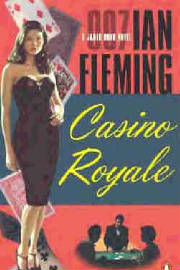 CASINO ROYALE. Ian Fleming. 1953.
This excellent novel introduced the world to James Bond, 007, who is a much more dimensional and complicated character
than in the films. In this adventure his skill in gambling makes him the best man to ensure the disgrace and utter defeat
of a Russian agent known as “le Chiffre” [the cypher], who has used millions of the state's
money to finance a venture – whore houses -- which should have made him many millions more. Unfortunately, the houses
of ill repute have been shut down and le Chiffre finds himself unable to refill the coffers he has “borrowed”
from. He goes to Royale-les-Eaux in France to try to win the money back at baccarat, and Bond – given quite a bit of
cash to play with – is told to make sure that he doesn't win at all. In this he is aided somewhat by CIA agent Felix
Leiter and British agent Vesper Lynd. Before the story is over Bond is horribly tortured – a
repeated whacking on his private areas as he sits naked in a cane chair with the bottom cut out – and has his heart
bent out of shape by an unexpected betrayal.
Bond is not happy that “a girl” has been assigned to this adventure. As he puts
it “Women were for recreation. On a job, they got in the way and fogged things up with sex and hurt feelings and all
the emotional baggage they carried around. One had to look out for them and take care of them.” Bond's attitude was
fairly typical for the time period. Over the decades, of course, he would meet many highly qualified and competent female
agents and temper his views quite a bit.
There is a gruesome and graphic description of the effects of a bomb that explodes upon two
men who were hoping to use the explosive to kill Bond. Bond feels like vomiting when he sees the carnage, but later on enjoys
a good meal up in his room. This establishes the fact that Bond is not completely deadened inside but also the fact that he
is a hardened agent who has already seen and experienced many horrible things before this story even begins.
Bond orders a special martini that is of his own invention. “Three measures of Gordon's,
one of vodka, half a measure of Kina Lillet. Shake it very well until it's ice-cold, then add a large thin slice of lemon
peel.” Felix suggests he call it the Molotov cocktail after the explosion of the afternoon. Bond wants to call it “The
Vesper” after Vesper Lynd. After the events of this novel, it's unlikely he would refer to it that way ever again. Bond
explains that he takes great pleasure in what he eats and drinks because, being a bachelor, he eats most meals alone and it
makes them more interesting if they are elaborate.
Bond is disenchanted with the reality of what it means to be a double 0 with a license to kill.
It is established that he does not have a casual attitude toward murder although he can act as executioner for his government
when required. He is troubled by the fact that what constitutes a good or bad guy keeps changing with the political situation.
He does what he has to do, puts bad thoughts out of his mind, but is not entirely devoid of conscience. “Like all harsh,
cold men,” writes Fleming, “he was easily tipped over into sentiment." He establishes a pattern of being too immune
to the charm and delicacies of attractive women, often to his great regret. In this novel, he falls in love with Vesper Lynd
and plans to ask her to marry him, but something disturbing in her demeanor puts him off.
Vesper is a sad character in many ways. She does the wrong thing, but she does it out of love.
Bond can't see that in a way she was forced into her actions. He can only see the damage she's done, especially to his heart.
Fleming doesn't develop all of this as much as another writer might have, but he was not writing a romantic story after all.
Bond has his first encounter with SMERSH, an agent of which cuts its insignia into his hand.
At the end of the book he forgets all thoughts of resigning and vows to spend his days hunting them down. Casino Royale is well-written, occasionally chilling, and extremely suspenseful not only during the breathless
baccarat game that Bond nearly loses but in the final chapters which focus on him and Vesper, and which seem to build inexorably
to a haunting and terrible finale.
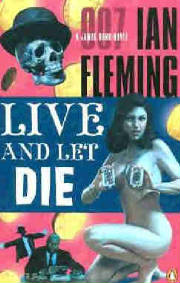 LIVE AND LET DIE. Ian Fleming. 1954. Bond joins forces with American operative Felix Leiter to take on the super Black
criminal Mr. Big (Buonaparter Ignace Gallia), who controls Harlem and is stealing Bloody Morgan's pirate treasure from an
island stronghold in Jamaica. Big is an agent of SMERSH, and his followers are convinced that he is in actuality the dread
spirit Baron Samedi. Big's concubine, Solitaire (Simone Latrell), is a beautiful woman with some alleged psychic power who
runs away with Bond when he goes down to St. Petersburg to investigate the Florida connection of Big's illegal trade. Two
of the book's best sequences wound up not in the film version of Live and Let Die
but in other Bond movies. Felix Leiter's being fed to sharks in a warehouse – his body is dumped
with wrapping paper that reads “He disagreed with something that ate him” -- was used years later in License
to Kill, and this book's climax was lifted for the ending of For Your Eyes
Only. Mr. Big ties Bond and Solitaire together and drags them behind his boat in the
water, hoping the blood from their wounds as they are pulled over the coral reefs will attract carnivorous fish. The sequence
in this book is rather brief, however, not like the memorably harrowing scene in For Your Eyes Only. Quarrel and Strangways, both of whom get killed in Dr. No (book and
movie) first appear in this novel.
Fleming's stereotypical descriptions of the senior population of St. Petersburg
positively shriek his middle-aged terror of becoming old and comparatively inactive; Bond is decidedly senior-phobic. Fleming's
underwater descriptions are quite good as Bond has encounters with an octopus and a whole bunch of barracuda that Mr. Big
has driven into a frenzy by dumping offal into the water around his boat. Bond's fear of flying – his fate is totally
out of his control – is very well described by Fleming, who probably felt the same. Fleming reveals fairly up to date
(for the 1950's!) attitudes toward Blacks, even if he is a bit patronizing. One does not get the sense that Mr. Big is villainous
because he is black. Indeed, M says: “..the Negro races are just beginning to throw up geniuses in all the professions
– scientists, writers, doctors. It's about time they turned out a great criminal.” Although there had been Great
Men (and Women) of all sorts in the Black community long before the 1950's. Mr. Big is a memorable and very colorful character,
but he's not developed as well as other Bond villains, probably because Fleming simply couldn't relate to him, his background,
history, and ethnicity.
Live and Let Die is a good read, if not quite on the level of the
best of Fleming's Bond adventures.
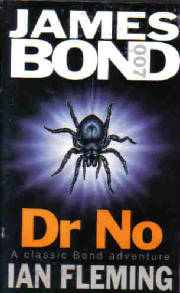 DR. NO. Ian Fleming. 1958.
When an agent named Strangways and his attractive secretary disappear in Jamaica, James Bond
is sent to investigate even though everyone seems to think the couple just ran away together. Instead he discovers that a
sinister part-Chinese man, Dr. No -- working for the Russians -- is taking control of guided missiles and knocking them out
of the sky. He operates from a lonely island called Crab Key, where he mines guano (bird dung) as a cover operation. Crab
Key was also home to some endangered bird species and Audubon Society members, most of whom have mysteriously disappeared.
Bond meets a beautiful girl with a broken nose named Honeychile “Honey” Ryder who comes to Crab Key to find valuable
shells, and winds up a prisoner of No along with Bond. But not before they come afoul of a metallic “dragon” with
a flamethrower and men inside. Quarrel, a Jamaican who first appeared in Live and Let Die,
is roasted by the dragon. Dr. No, who has hooks for hands, is described as looking like “a giant venomous worm wrapped
in grey tin-foil.”
Bond has a scary encounter
with a deadly and poisonous giant centipede – he actually runs to the bathroom to throw up after his encounter with
the thing – but the most amazing creature he comes across is a hungry giant squid that Dr. No actually keeps
in captivity. This occurs at the end of the book's most memorable sequence, when Bond must try to survive an escape route
tunnel that is full of deadly traps – extreme heat and tarantulas – and winds up falling into a pool that is home
to the tentacled monstrosity. This sequence reflects the pulp influence on the James Bond series; In fact, Dr. No was inspired
by Sax Rohmer's (admittedly more interesting and dimensional) creation, Dr. Fu
Manchu. Even, Fu Manchu, however, was not capable of capturing a giant squid and keeping it alive, although he did employ
plenty of other strange creatures. Dr. No wants to use crabs to take care of Honey, and ties her down in their migratory path,
but he is unaware that the crabs won't bite unless there's an open wound. Dr. No winds up being suffocated in his own –
pardon the expression – shit.
An excellent 007 adventure full of suspense and atmosphere. The tunnel escape sequence is one
of Fleming's most harrowing and Dr. No ranks with the best of the Fleming novels.
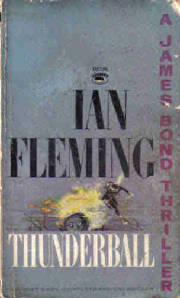 THUNDERBALL. Ian Fleming. 1961.
Fleming originally developed Thunderball as a screen treatment for a new producer,
who hired Jack Whittingham to turn it into a screenplay When filming stalled, Fleming decided to turn his treatment into a
novel without the permission of the producer who commissioned it, nor of Whittingham. This situation led to a number of legal
entanglements and resulted in two films being made of the same story, Thunderball
and – years later -- Never Say Never Again, both of which starred Sean
Connery as Bond. In later editions of Thunderball a note was included as to
the novel being based on a treatment and screenplay.
Thunderball introduced Ernst Stavros
Blofeld and the criminal organization SPECTRE [Special Executive for Counter-Intelligence, Terrorism, Revenge and Extortion];
by the time the film version had come out, the group had been mentioned in the earlier Bond films such as Dr. No, although they were not part of the novels.
SPECTRE successfully schemes to steal two
atom bombs and blackmails the world with them. Bond is sent to Nassau on a hunch, and discovers that Emilio Largo, an alleged
treasure hunter – and Number 2 in SPECTRE -- is the key architect of the plot. He enlists the aid of Largo's mistress
Dominetta “Domino” Vitale to stop Largo from executing his deadly plan.
Thunderball is an excellent Bond adventure with some great sequences
but it does have a flaw. The last quarter of the novel gets bogged down in lots of talk as Bond, Felix Leiter and other officials
seem to endlessly discuss what to do about the situation. The underwater climax, however, is brief and exciting. Fleming gives
interesting histories for Blofeld, and for Giuseppi Petacchi, the utterly amoral pilot – and brother of Domino –
who steals the plane carrying the bombs. Although Felix Leiter supposedly lost an arm and half a leg in Live and Let Die,
in Thunderball he seems only to have lost one of his hands. Leiter gives a Bahamian bartender the business for pouring
him a weak martini, and explains the business of bars to Bond. There is an eerie scene when Bond finds the plane and the corpse
of Petacchi and the other men underwater, and Fleming describes how the interior is full of hundreds of small, patiently waiting
octopuses, some of them nibbling at the faces of the men – it all gives Bond the willies and he dashes out of there.
The opening chapters at the health spa Shrublands, as well as the introduction of SPECTRE in one deadly conference, are very
entertaining.
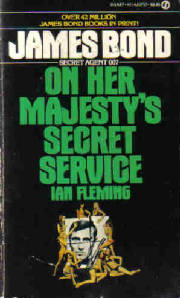
ON HER MAJESTY’S SECRET SERVICE. Ian Fleming. 1963. In one of Fleming’s best Bond novels Bond falls in love
with an exciting, beautiful – if deeply troubled – woman, Teresa (Tracy) who turns out to be the daughter of the
head of the French criminal organization the Union Corse, Marc-Ange Draco. (Years later Draco would figure to a large degree
in one of Raymond Benson’s 007 novels.) After Tracy, who lost a child, attempts suicide, Draco asks Bond to guard and
romance her, and in exchange, Draco will use his resources to track down Ernest Stavros Blofeld, whom no one has been able
to find after the Thunderball caper. Turns out that Blofeld, with his wardress-like assistant Irma Bunt, is running
an allergy-curing clinic in Switzerland, which is attached to an exclusive resort. The vain Blofeld is also hoping that the
College of Arms will recognize that he deserves to be given the title of Comte de Bleuville, so – pretending to be Sir
Hilary Bray of the College – Bond travels to Switzerland to investigate and hopefully nail Blofeld. There he finds a
bevy of beautiful young women who all have a phobia to something, and are the cornerstones of Blofeld’s latest diabolical
plot. (I believe this was one of the earliest novels to deal with biological warfare.) Bond enlists the aid of Draco and his
Union Corse thugs to stop Blofeld’s master plan. Two scenes that made it into the movie include the fantastic bob sled
chase between Bond and Blofeld. The bit with a pursuing henchman of Blofeld’s skiing right into a train as he chases
after Bond and being gruesomely dispatched was changed into an encounter with a snow blower in the film. (In general the movie
follows the book pretty faithfully if not to the letter.) The book bogs down a bit in the final quarter, but otherwise is
quite entertaining and suspenseful.
Some might feel Bond has way too much admiration for Draco, but 007 recognizes a kindred spirit in the fact that both men
live outside the normal world and are addicted to danger. At one point M and Bond discuss the Nero Wolfe detective novels
by Rex Stout, which 007 declares "readable" -- M can’t get past Wolfe’s penchant for growing "disgusting" orchids.
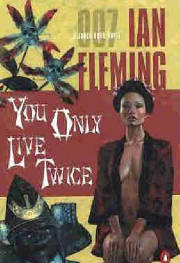
YOU ONLY LIVE TWICE. Ian Fleming. 1964. One of Fleming’s finest Bond novels has him suffering a deep depression after
the murder of his wife in On Her Majesty’s Secret Service. M sends him on an assignment in Japan, where he meets
Tiger Tanaka (a kind of Japanese "M") and learns a lot about the "violent" Japanese culture. In exchange for a certain spying
device coveted by M, Tiger asks Bond to assassinate a foreigner named Dr. Shatterhand, who has taken over a castle and filled
the property with exotic plants and deadly poisons. Hundreds of Japanese citizens flock to this place each month to commit
suicide. Shatterhand, who thinks he’s performing a public service (no more "messy deaths" on trains and trams), turns
out to be one of Bond’s most hated and nefarious enemies. Preparing for his mission, Bond is taken to an island where
he meets the beautiful pearl diver Kissy Suzuki, who falls in love with him. The glimpses into Japanese culture and attitudes
toward suicide and death etc. are fascinating, although much of this material might be dated. Tiger has a few choice words
to say about Western culture as well. The final chapters in the "Garden of Death" are creepy and exciting. Shatterhand even
has a lake stocked with piranha, who strip the flesh off of a couple of victims (in real life piranha are not quite so voracious
or savage.) In the castle itself, Bond falls through a trapdoor and is forced upon a seat (with a large hole in the middle)
directly above a geyser spray of hot, scalding mud. There is a climactic duel with sword and staff, and it all ends in a most
satisfactory manner. Bond is at his most dimensional in this novel, betraying little touches of humanity throughout the story
(such as when he feels sorry for one of Tiger’s recruits who dies during a training session). And the book is always
rich in atmosphere, a very dark suspense novel indeed. The title of the novel comes from a haiku that Bond dreams up
hurriedly at Tiger’s urging: "You only live twice. Once when you’re born. Once when you look death in the face."
[Sounds impressive, but is virtually meaningless.] This is a great sequel to On Her Majesty’s Secret Service.
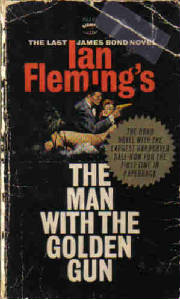 THE MAN WITH THE GOLDEN GUN. Ian Fleming. 1965. Ian Fleming's final Bond novel is one of his best. After the events of
You Only Live Twice, Bond is brainwashed by the Russians and sent back to London to
assassinate M! M knows that the best medicine for 007 is a major and dangerous case, so he assigns him to the assassination
of Francisco (Paco) “Pistols” Scaramanga, a notorious hit man [mostly for the KGB] who
has been responsible for the murders of many agents. Returning to the scene of several previous adventures, Jamaica, Bond
as “Mark Hazard” manages to become an associate of Scaramanga's, when the latter entertains
some hoods in the hopes they will buy into a new hotel that needs to be completed. One of these men is a Russian agent who
is out to kill Bond and learns who Hazard really is. Scaramanga comes up with a sinister scheme to destroy Bond, but Bond
outwits him with the help of Felix Leiter. Bond and his target have a final confrontation in the swamps of Savannah La Mar.
Fleming provides an interesting origin for Scaramanga involving a runaway elephant, as well as a dubious psychological report
that suggests he might be a repressed homosexual [nothing ever comes of this tiresome angle]. Scaramanga may lack the magnitude
and awe of other Bond villains, but he is nevertheless a highly interesting character, if essentially a crude one.
Mary Goodnight, Bond's former secretary, gets involved in the action briefly,
and figures [in an indirect way] in Scaramanga's fiendish trap for 007. Bond briefly wonders about Honeychile Ryder of Dr.
No, who had apparently married a doctor in Philadelphia. Bond's bedtime reading material is Profiles in Courage
by JFK. Bond turns down a knighthood at the end, having no desire to be a public person and all that rot. The Triple-X decyphering
machine is mentioned more than once. Bond begins a relationship with Mary Goodnight at the end of the book while acknowledging
that domestic bliss, one woman, monogamy -- “a room with one view” -- was simply not enough for him. An excellent
Bond adventure with many good sequences.
|